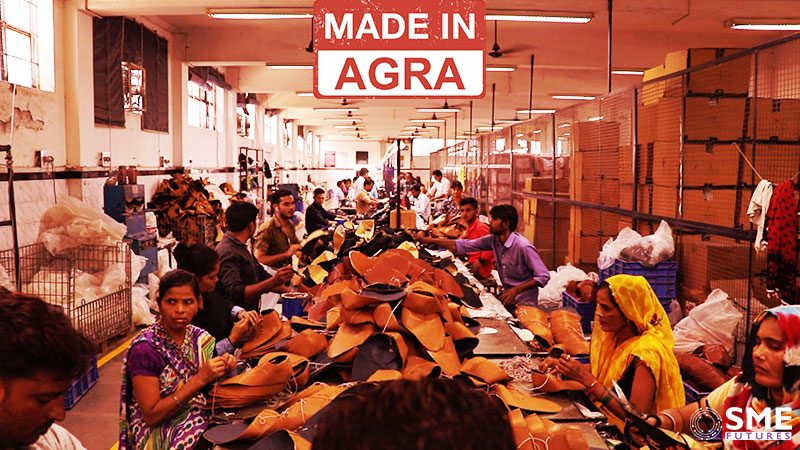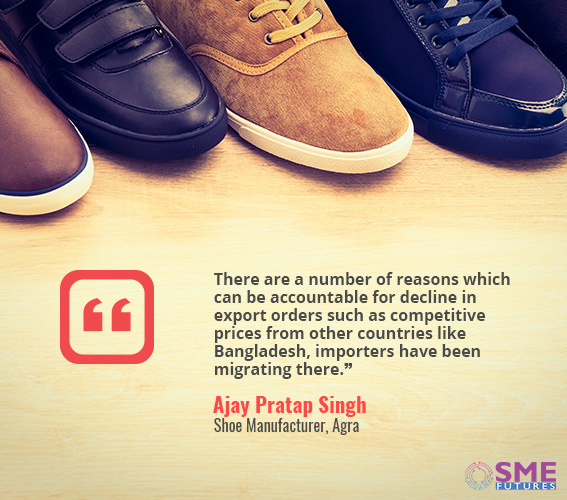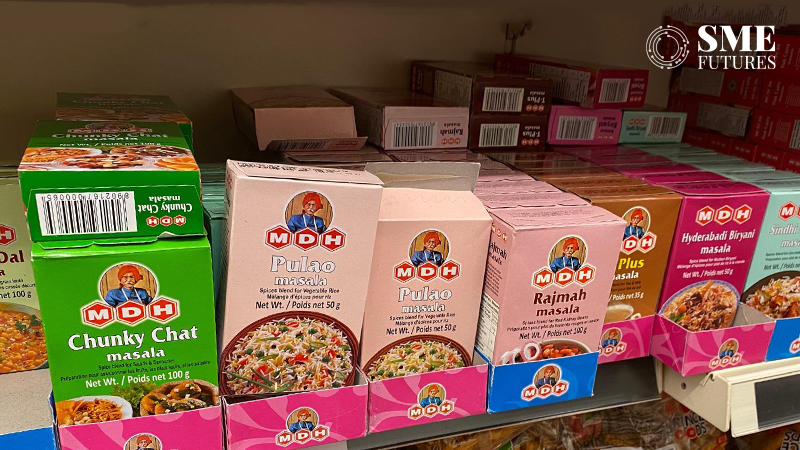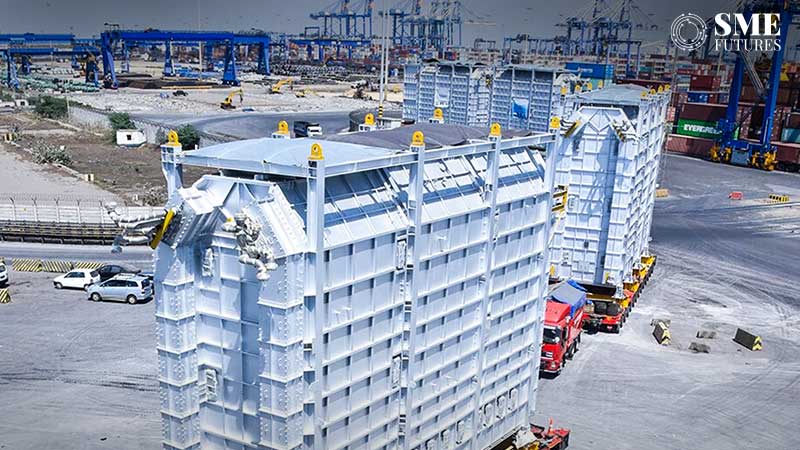Agra’s footwear industries: A heritage that contributes to India’s economy
The hub of footwear manufacture in India since Mughal era, Agra is slowly losing in edge to more business-friendly ecosystems […]
Anushruti Singh January 7, 2019

MORE IN Focus
It’s rush hour for gold in 2024, and India inc is riding new trends
IPL’s impact on hospitality: Boosting tourism, hotel bookings, and revenue surge
Will 45-day payment rule revolutionise MSME support?
The future of digital banking: Lessons from Paytm Payments Bank’s regulatory hurdles
Empowering women imperative for inclusive development in India
The hub of footwear manufacture in India since Mughal era, Agra is slowly losing in edge to more business-friendly ecosystems in neighbouring states, not very effective implementation of the central Government’s MSME policies, the Taj trapezium, and exports from China. With its army of highly skilled leather processing and footwear manufacturing workers and artisans, Agra still accounts for 65 per cent and 28 per cent of all domestic consumption and export of footwear, respectively, but the city’s ease of business doing ranking has slipped to the current 14, from 10 in 2015. “Shoe making started (in Agra) in the Mughal era with leather mushaks which were used to carry hing, converting it into shoes,” we were informed by Puran Dawar, Chairman, Dawar Footwear Industries, and President, Agra Footwear Manufacturers and Exporters Chamber (AFMEC). He also told us that it was from the 1960s and 1980s that the city’s footwear industries flourished the most, thanks primarily to footwear exports to the erstwhile Soviet Union. According to conservative estimates, 13 per cent of all shoe trade in Agra in 1963 was with Russia and its satellite countries. Shoe exports to the Soviet Union in the early 1980s was worth ₹1,200 crores from the 150 odd shoe exporters in Agra.It was after the fall of the Soviet Union that the decline started and other factors that followed, such as the Taj Trapezium, added to the worrisome slowing down of the industry’s growth. Currently, industry watchers say that Agra’s leather and footwear industries need help more sooner than later.According to our sources in the industry, Agra is still one of the biggest clusters in the footwear sector in India among Kolkata, Kanpur and Chennai. “There are around 10,000 micro-size units; 150 small-scale industry units; around 30 medium-scale units; and, around 15 large-scale units in the city,” says Dawar. He also added that, currently, more than 2 lakh pairs are manufactured in the city everyday day and there are over 3.5 lakh people employed in the footwear segment in Agra.
“Shoe making started (in Agra) in the Mughal era with leather mushaks which were used to carry hing, converting it into shoes,” we were informed by Puran Dawar, Chairman, Dawar Footwear Industries, and President, Agra Footwear Manufacturers and Exporters Chamber (AFMEC). He also told us that it was from the 1960s and 1980s that the city’s footwear industries flourished the most, thanks primarily to footwear exports to the erstwhile Soviet Union. According to conservative estimates, 13 per cent of all shoe trade in Agra in 1963 was with Russia and its satellite countries. Shoe exports to the Soviet Union in the early 1980s was worth ₹1,200 crores from the 150 odd shoe exporters in Agra.It was after the fall of the Soviet Union that the decline started and other factors that followed, such as the Taj Trapezium, added to the worrisome slowing down of the industry’s growth. Currently, industry watchers say that Agra’s leather and footwear industries need help more sooner than later.According to our sources in the industry, Agra is still one of the biggest clusters in the footwear sector in India among Kolkata, Kanpur and Chennai. “There are around 10,000 micro-size units; 150 small-scale industry units; around 30 medium-scale units; and, around 15 large-scale units in the city,” says Dawar. He also added that, currently, more than 2 lakh pairs are manufactured in the city everyday day and there are over 3.5 lakh people employed in the footwear segment in Agra. Agra’s huge potential to impact the global footwear market has been recognized by the government, which released a special package of ₹2600 crore last year for implementing its Indian Footwear, Leather & Accessories Development Programme. In tandem, MSME Development Institutes are working on imparting business and technical knowledge of the sector to already-existing entrepreneurs as well as those who want to work in this sector.Though these, and other similar efforts, have started making a difference, it is not much. Government statistics show a dip over the past few years in the numbers of students that enroll for entrepreneurship and skill-development programmes. The 2017 Central Footwear Training Institute, Agra, annual report shows that the number of students in the institute in 2014–15, 2015–16 and 2016–17 was 9,210, 4,573 and 2,697, respectively. The only reason that comes to mind here is that the average daily earnings of a skilled footwear worker is a pittance compared to the earnings of even an unskilled daily labourer in nearby New Delhi, and this situation will change only once the sector regains its old glory and becomes as profitable as it once was. An skilled worker I spoke with in Agra said his daily earnings were in the range ₹200–₹250, compared to the minimum wage of ₹485 of his New Delhi counterpart.Another red flag is India’s declining footwear export, which is negatively impacting revenues in even the Agra footwear sector. World footwear data states that in year 2016, India exported 236 million pairs out of 2.26 billion pairs manufactured i.e. 1.7 per cent share in worldwide exports. While in 2017 first semester, Indian exports went down again by 2.8 per cent reaching only 97 per cent of the amount registered in similar period last year. India exports mainly leather footwear, representing a 73 per cent share in total, and these have declined 8.2 per cent in the first six months of 2017, driving the overall fall in exports value.Although we could not come across specific data on how much Agra is losing in terms of revenue as a result of the decline in exports, the exporters and manufacturers we spoke with confirmed that they are facing problems in exporting the finished goods. Ajay Pratap Singh, one such exporter, told us that “There are number of reasons which can be accountable for decline in export orders such as competitive prices from other countries like Bangladesh, importers have been migrating there. Diminishing manufacturing units is also a reason; even government policies are not giving us much relief.”
Agra’s huge potential to impact the global footwear market has been recognized by the government, which released a special package of ₹2600 crore last year for implementing its Indian Footwear, Leather & Accessories Development Programme. In tandem, MSME Development Institutes are working on imparting business and technical knowledge of the sector to already-existing entrepreneurs as well as those who want to work in this sector.Though these, and other similar efforts, have started making a difference, it is not much. Government statistics show a dip over the past few years in the numbers of students that enroll for entrepreneurship and skill-development programmes. The 2017 Central Footwear Training Institute, Agra, annual report shows that the number of students in the institute in 2014–15, 2015–16 and 2016–17 was 9,210, 4,573 and 2,697, respectively. The only reason that comes to mind here is that the average daily earnings of a skilled footwear worker is a pittance compared to the earnings of even an unskilled daily labourer in nearby New Delhi, and this situation will change only once the sector regains its old glory and becomes as profitable as it once was. An skilled worker I spoke with in Agra said his daily earnings were in the range ₹200–₹250, compared to the minimum wage of ₹485 of his New Delhi counterpart.Another red flag is India’s declining footwear export, which is negatively impacting revenues in even the Agra footwear sector. World footwear data states that in year 2016, India exported 236 million pairs out of 2.26 billion pairs manufactured i.e. 1.7 per cent share in worldwide exports. While in 2017 first semester, Indian exports went down again by 2.8 per cent reaching only 97 per cent of the amount registered in similar period last year. India exports mainly leather footwear, representing a 73 per cent share in total, and these have declined 8.2 per cent in the first six months of 2017, driving the overall fall in exports value.Although we could not come across specific data on how much Agra is losing in terms of revenue as a result of the decline in exports, the exporters and manufacturers we spoke with confirmed that they are facing problems in exporting the finished goods. Ajay Pratap Singh, one such exporter, told us that “There are number of reasons which can be accountable for decline in export orders such as competitive prices from other countries like Bangladesh, importers have been migrating there. Diminishing manufacturing units is also a reason; even government policies are not giving us much relief.” A 2016 ICRA report on the Indian footwear sector confirms the trend. The report says that appreciation in Rupee value against major currencies; regulations and restrictions on slaughter houses and tanneries that impacted availability of raw material; and reforms such as demonetisation and GST have had adverse effects on the sector. The report also stated current consumer trends shifting away from traditionally made shoes to global brands. ICRA figures show a decline for two consecutive years by ~9 per cent in FY16 and ~5 per cent in FY17. Further in April–June 2017–2018, the overall export in leather footwear and leather goods dipped by 4.89 per cent when compared to April–June 16–17 cycle.Despite many government initiatives and budget notifications for the sector, footwear manufacturers and exporters think that a lot still remains to be done. Dawar underscored the importance of putting a single-window system in place. He says that the sector in Uttar Pradesh is not getting much benefits from the much-touted initiatives. “The initiatives for the sector are totally on paper. Single window system is not effective at all for us,” according to him. Footwear manufacturers are also questioning the ambitious target of $10 billion in export revenues by 2024–25 at the time when government has shut down many (unauthorised) tanneries and the many footwear factories in the Taj Trapezium Zone (TTZ) have been sealed. “Tanneries are banned in TTZ and manufacturers are facing issues in procuring raw hides. Due to this, manufacturing is suffering and resulting in the decreasing trend in the exports,” Singh told us.
A 2016 ICRA report on the Indian footwear sector confirms the trend. The report says that appreciation in Rupee value against major currencies; regulations and restrictions on slaughter houses and tanneries that impacted availability of raw material; and reforms such as demonetisation and GST have had adverse effects on the sector. The report also stated current consumer trends shifting away from traditionally made shoes to global brands. ICRA figures show a decline for two consecutive years by ~9 per cent in FY16 and ~5 per cent in FY17. Further in April–June 2017–2018, the overall export in leather footwear and leather goods dipped by 4.89 per cent when compared to April–June 16–17 cycle.Despite many government initiatives and budget notifications for the sector, footwear manufacturers and exporters think that a lot still remains to be done. Dawar underscored the importance of putting a single-window system in place. He says that the sector in Uttar Pradesh is not getting much benefits from the much-touted initiatives. “The initiatives for the sector are totally on paper. Single window system is not effective at all for us,” according to him. Footwear manufacturers are also questioning the ambitious target of $10 billion in export revenues by 2024–25 at the time when government has shut down many (unauthorised) tanneries and the many footwear factories in the Taj Trapezium Zone (TTZ) have been sealed. “Tanneries are banned in TTZ and manufacturers are facing issues in procuring raw hides. Due to this, manufacturing is suffering and resulting in the decreasing trend in the exports,” Singh told us. Another challenge which manufacturers are facing is rising capital costs, which small manufacturers cannot easily bear on account of the high interest rates on commercial loans which are in the range 9%–14%. “Capital cost is really high in India. Other countries in spite of the best of the infrastructure compare to us are funded at 2%–3%. But here interest rates are quite high which is sometimes unaffordable for small manufacturers” says Singh.“We can’t compete fairly even in in-house clusters when there is a gap of supply on the raw material front. That’s why small manufacturers are moving rapidly towards synthetic leather manufacturing,” says one shoe manufacturers in Agra, on conditions of anonymity. For countering the issue of raw material unavailability, Dawar say the two measures that will be effective are: (i) An effective single-window system; (ii) Independent compliance audits.Other major roadblocks for small shoe vendors and manufacturers are competition from e-commerce and premiumization drives by global and national brands that are resulting in a shift in consumer trends. With rise in in incomes of middle-class households and those in younger age brackets, demand for premium brands have eaten up a major chunk of traditional footwear’s share. According to Associated Chambers of Commerce and Industries of India (ASSOCHAM) data, domestic footwear sales registered around ₹4.5 billion in 2017, of which 26 per cent was sales of global and national brands and this number, the data says, is expected to rise to 29 per cent by end of fiscal 2020.
Another challenge which manufacturers are facing is rising capital costs, which small manufacturers cannot easily bear on account of the high interest rates on commercial loans which are in the range 9%–14%. “Capital cost is really high in India. Other countries in spite of the best of the infrastructure compare to us are funded at 2%–3%. But here interest rates are quite high which is sometimes unaffordable for small manufacturers” says Singh.“We can’t compete fairly even in in-house clusters when there is a gap of supply on the raw material front. That’s why small manufacturers are moving rapidly towards synthetic leather manufacturing,” says one shoe manufacturers in Agra, on conditions of anonymity. For countering the issue of raw material unavailability, Dawar say the two measures that will be effective are: (i) An effective single-window system; (ii) Independent compliance audits.Other major roadblocks for small shoe vendors and manufacturers are competition from e-commerce and premiumization drives by global and national brands that are resulting in a shift in consumer trends. With rise in in incomes of middle-class households and those in younger age brackets, demand for premium brands have eaten up a major chunk of traditional footwear’s share. According to Associated Chambers of Commerce and Industries of India (ASSOCHAM) data, domestic footwear sales registered around ₹4.5 billion in 2017, of which 26 per cent was sales of global and national brands and this number, the data says, is expected to rise to 29 per cent by end of fiscal 2020. E-commerce platforms are also giving brick-and-mortar retailers stiff competition. Due to predatory pricing, low-tech knowledge and lack of digital presence, small businesses are lagging much behind online marketplaces. Buyers are also gravitating towards online shopping because of the convenience and heavy discounts on offer. The footwear sector in Agra needs to establish an online presence in order to compete with e-commerce and needs government help to do so.Despite the many challenges, Agra’s footwear sector is slowly but surely transforming into a more technology and innovation driven sector, thanks to the collective efforts of Agra Footwear Association and the MSME Development Institute. Moreover, players in the sector have also started enhancing their channel strategies by participating in footwear expos both in India and abroad. “Agra is definitely growing, thanks to international expos we have now expanded our presence from Central Europe to the US, through New Zealand and Caribbean countries,” Dawar told us. He also informed us about the annual Meet At Agra event which has now become an effective platform for networking.Reviving Agra’s footwear industry and raising it up to the level it was at just a couple of decades ago is not an easy task. But no matter how tough the job is or how long it takes, the government should focus on it very hard and work along with entrepreneurs and workers not only because it is a heritage worth preserving but also because it is an industry that has the potential to contribute significantly to the nations GDP, along with providing livelihood and employment to many.
E-commerce platforms are also giving brick-and-mortar retailers stiff competition. Due to predatory pricing, low-tech knowledge and lack of digital presence, small businesses are lagging much behind online marketplaces. Buyers are also gravitating towards online shopping because of the convenience and heavy discounts on offer. The footwear sector in Agra needs to establish an online presence in order to compete with e-commerce and needs government help to do so.Despite the many challenges, Agra’s footwear sector is slowly but surely transforming into a more technology and innovation driven sector, thanks to the collective efforts of Agra Footwear Association and the MSME Development Institute. Moreover, players in the sector have also started enhancing their channel strategies by participating in footwear expos both in India and abroad. “Agra is definitely growing, thanks to international expos we have now expanded our presence from Central Europe to the US, through New Zealand and Caribbean countries,” Dawar told us. He also informed us about the annual Meet At Agra event which has now become an effective platform for networking.Reviving Agra’s footwear industry and raising it up to the level it was at just a couple of decades ago is not an easy task. But no matter how tough the job is or how long it takes, the government should focus on it very hard and work along with entrepreneurs and workers not only because it is a heritage worth preserving but also because it is an industry that has the potential to contribute significantly to the nations GDP, along with providing livelihood and employment to many.
 “Shoe making started (in Agra) in the Mughal era with leather mushaks which were used to carry hing, converting it into shoes,” we were informed by Puran Dawar, Chairman, Dawar Footwear Industries, and President, Agra Footwear Manufacturers and Exporters Chamber (AFMEC). He also told us that it was from the 1960s and 1980s that the city’s footwear industries flourished the most, thanks primarily to footwear exports to the erstwhile Soviet Union. According to conservative estimates, 13 per cent of all shoe trade in Agra in 1963 was with Russia and its satellite countries. Shoe exports to the Soviet Union in the early 1980s was worth ₹1,200 crores from the 150 odd shoe exporters in Agra.It was after the fall of the Soviet Union that the decline started and other factors that followed, such as the Taj Trapezium, added to the worrisome slowing down of the industry’s growth. Currently, industry watchers say that Agra’s leather and footwear industries need help more sooner than later.According to our sources in the industry, Agra is still one of the biggest clusters in the footwear sector in India among Kolkata, Kanpur and Chennai. “There are around 10,000 micro-size units; 150 small-scale industry units; around 30 medium-scale units; and, around 15 large-scale units in the city,” says Dawar. He also added that, currently, more than 2 lakh pairs are manufactured in the city everyday day and there are over 3.5 lakh people employed in the footwear segment in Agra.
“Shoe making started (in Agra) in the Mughal era with leather mushaks which were used to carry hing, converting it into shoes,” we were informed by Puran Dawar, Chairman, Dawar Footwear Industries, and President, Agra Footwear Manufacturers and Exporters Chamber (AFMEC). He also told us that it was from the 1960s and 1980s that the city’s footwear industries flourished the most, thanks primarily to footwear exports to the erstwhile Soviet Union. According to conservative estimates, 13 per cent of all shoe trade in Agra in 1963 was with Russia and its satellite countries. Shoe exports to the Soviet Union in the early 1980s was worth ₹1,200 crores from the 150 odd shoe exporters in Agra.It was after the fall of the Soviet Union that the decline started and other factors that followed, such as the Taj Trapezium, added to the worrisome slowing down of the industry’s growth. Currently, industry watchers say that Agra’s leather and footwear industries need help more sooner than later.According to our sources in the industry, Agra is still one of the biggest clusters in the footwear sector in India among Kolkata, Kanpur and Chennai. “There are around 10,000 micro-size units; 150 small-scale industry units; around 30 medium-scale units; and, around 15 large-scale units in the city,” says Dawar. He also added that, currently, more than 2 lakh pairs are manufactured in the city everyday day and there are over 3.5 lakh people employed in the footwear segment in Agra. Agra’s huge potential to impact the global footwear market has been recognized by the government, which released a special package of ₹2600 crore last year for implementing its Indian Footwear, Leather & Accessories Development Programme. In tandem, MSME Development Institutes are working on imparting business and technical knowledge of the sector to already-existing entrepreneurs as well as those who want to work in this sector.Though these, and other similar efforts, have started making a difference, it is not much. Government statistics show a dip over the past few years in the numbers of students that enroll for entrepreneurship and skill-development programmes. The 2017 Central Footwear Training Institute, Agra, annual report shows that the number of students in the institute in 2014–15, 2015–16 and 2016–17 was 9,210, 4,573 and 2,697, respectively. The only reason that comes to mind here is that the average daily earnings of a skilled footwear worker is a pittance compared to the earnings of even an unskilled daily labourer in nearby New Delhi, and this situation will change only once the sector regains its old glory and becomes as profitable as it once was. An skilled worker I spoke with in Agra said his daily earnings were in the range ₹200–₹250, compared to the minimum wage of ₹485 of his New Delhi counterpart.Another red flag is India’s declining footwear export, which is negatively impacting revenues in even the Agra footwear sector. World footwear data states that in year 2016, India exported 236 million pairs out of 2.26 billion pairs manufactured i.e. 1.7 per cent share in worldwide exports. While in 2017 first semester, Indian exports went down again by 2.8 per cent reaching only 97 per cent of the amount registered in similar period last year. India exports mainly leather footwear, representing a 73 per cent share in total, and these have declined 8.2 per cent in the first six months of 2017, driving the overall fall in exports value.Although we could not come across specific data on how much Agra is losing in terms of revenue as a result of the decline in exports, the exporters and manufacturers we spoke with confirmed that they are facing problems in exporting the finished goods. Ajay Pratap Singh, one such exporter, told us that “There are number of reasons which can be accountable for decline in export orders such as competitive prices from other countries like Bangladesh, importers have been migrating there. Diminishing manufacturing units is also a reason; even government policies are not giving us much relief.”
Agra’s huge potential to impact the global footwear market has been recognized by the government, which released a special package of ₹2600 crore last year for implementing its Indian Footwear, Leather & Accessories Development Programme. In tandem, MSME Development Institutes are working on imparting business and technical knowledge of the sector to already-existing entrepreneurs as well as those who want to work in this sector.Though these, and other similar efforts, have started making a difference, it is not much. Government statistics show a dip over the past few years in the numbers of students that enroll for entrepreneurship and skill-development programmes. The 2017 Central Footwear Training Institute, Agra, annual report shows that the number of students in the institute in 2014–15, 2015–16 and 2016–17 was 9,210, 4,573 and 2,697, respectively. The only reason that comes to mind here is that the average daily earnings of a skilled footwear worker is a pittance compared to the earnings of even an unskilled daily labourer in nearby New Delhi, and this situation will change only once the sector regains its old glory and becomes as profitable as it once was. An skilled worker I spoke with in Agra said his daily earnings were in the range ₹200–₹250, compared to the minimum wage of ₹485 of his New Delhi counterpart.Another red flag is India’s declining footwear export, which is negatively impacting revenues in even the Agra footwear sector. World footwear data states that in year 2016, India exported 236 million pairs out of 2.26 billion pairs manufactured i.e. 1.7 per cent share in worldwide exports. While in 2017 first semester, Indian exports went down again by 2.8 per cent reaching only 97 per cent of the amount registered in similar period last year. India exports mainly leather footwear, representing a 73 per cent share in total, and these have declined 8.2 per cent in the first six months of 2017, driving the overall fall in exports value.Although we could not come across specific data on how much Agra is losing in terms of revenue as a result of the decline in exports, the exporters and manufacturers we spoke with confirmed that they are facing problems in exporting the finished goods. Ajay Pratap Singh, one such exporter, told us that “There are number of reasons which can be accountable for decline in export orders such as competitive prices from other countries like Bangladesh, importers have been migrating there. Diminishing manufacturing units is also a reason; even government policies are not giving us much relief.” A 2016 ICRA report on the Indian footwear sector confirms the trend. The report says that appreciation in Rupee value against major currencies; regulations and restrictions on slaughter houses and tanneries that impacted availability of raw material; and reforms such as demonetisation and GST have had adverse effects on the sector. The report also stated current consumer trends shifting away from traditionally made shoes to global brands. ICRA figures show a decline for two consecutive years by ~9 per cent in FY16 and ~5 per cent in FY17. Further in April–June 2017–2018, the overall export in leather footwear and leather goods dipped by 4.89 per cent when compared to April–June 16–17 cycle.Despite many government initiatives and budget notifications for the sector, footwear manufacturers and exporters think that a lot still remains to be done. Dawar underscored the importance of putting a single-window system in place. He says that the sector in Uttar Pradesh is not getting much benefits from the much-touted initiatives. “The initiatives for the sector are totally on paper. Single window system is not effective at all for us,” according to him. Footwear manufacturers are also questioning the ambitious target of $10 billion in export revenues by 2024–25 at the time when government has shut down many (unauthorised) tanneries and the many footwear factories in the Taj Trapezium Zone (TTZ) have been sealed. “Tanneries are banned in TTZ and manufacturers are facing issues in procuring raw hides. Due to this, manufacturing is suffering and resulting in the decreasing trend in the exports,” Singh told us.
A 2016 ICRA report on the Indian footwear sector confirms the trend. The report says that appreciation in Rupee value against major currencies; regulations and restrictions on slaughter houses and tanneries that impacted availability of raw material; and reforms such as demonetisation and GST have had adverse effects on the sector. The report also stated current consumer trends shifting away from traditionally made shoes to global brands. ICRA figures show a decline for two consecutive years by ~9 per cent in FY16 and ~5 per cent in FY17. Further in April–June 2017–2018, the overall export in leather footwear and leather goods dipped by 4.89 per cent when compared to April–June 16–17 cycle.Despite many government initiatives and budget notifications for the sector, footwear manufacturers and exporters think that a lot still remains to be done. Dawar underscored the importance of putting a single-window system in place. He says that the sector in Uttar Pradesh is not getting much benefits from the much-touted initiatives. “The initiatives for the sector are totally on paper. Single window system is not effective at all for us,” according to him. Footwear manufacturers are also questioning the ambitious target of $10 billion in export revenues by 2024–25 at the time when government has shut down many (unauthorised) tanneries and the many footwear factories in the Taj Trapezium Zone (TTZ) have been sealed. “Tanneries are banned in TTZ and manufacturers are facing issues in procuring raw hides. Due to this, manufacturing is suffering and resulting in the decreasing trend in the exports,” Singh told us. Another challenge which manufacturers are facing is rising capital costs, which small manufacturers cannot easily bear on account of the high interest rates on commercial loans which are in the range 9%–14%. “Capital cost is really high in India. Other countries in spite of the best of the infrastructure compare to us are funded at 2%–3%. But here interest rates are quite high which is sometimes unaffordable for small manufacturers” says Singh.“We can’t compete fairly even in in-house clusters when there is a gap of supply on the raw material front. That’s why small manufacturers are moving rapidly towards synthetic leather manufacturing,” says one shoe manufacturers in Agra, on conditions of anonymity. For countering the issue of raw material unavailability, Dawar say the two measures that will be effective are: (i) An effective single-window system; (ii) Independent compliance audits.Other major roadblocks for small shoe vendors and manufacturers are competition from e-commerce and premiumization drives by global and national brands that are resulting in a shift in consumer trends. With rise in in incomes of middle-class households and those in younger age brackets, demand for premium brands have eaten up a major chunk of traditional footwear’s share. According to Associated Chambers of Commerce and Industries of India (ASSOCHAM) data, domestic footwear sales registered around ₹4.5 billion in 2017, of which 26 per cent was sales of global and national brands and this number, the data says, is expected to rise to 29 per cent by end of fiscal 2020.
Another challenge which manufacturers are facing is rising capital costs, which small manufacturers cannot easily bear on account of the high interest rates on commercial loans which are in the range 9%–14%. “Capital cost is really high in India. Other countries in spite of the best of the infrastructure compare to us are funded at 2%–3%. But here interest rates are quite high which is sometimes unaffordable for small manufacturers” says Singh.“We can’t compete fairly even in in-house clusters when there is a gap of supply on the raw material front. That’s why small manufacturers are moving rapidly towards synthetic leather manufacturing,” says one shoe manufacturers in Agra, on conditions of anonymity. For countering the issue of raw material unavailability, Dawar say the two measures that will be effective are: (i) An effective single-window system; (ii) Independent compliance audits.Other major roadblocks for small shoe vendors and manufacturers are competition from e-commerce and premiumization drives by global and national brands that are resulting in a shift in consumer trends. With rise in in incomes of middle-class households and those in younger age brackets, demand for premium brands have eaten up a major chunk of traditional footwear’s share. According to Associated Chambers of Commerce and Industries of India (ASSOCHAM) data, domestic footwear sales registered around ₹4.5 billion in 2017, of which 26 per cent was sales of global and national brands and this number, the data says, is expected to rise to 29 per cent by end of fiscal 2020. E-commerce platforms are also giving brick-and-mortar retailers stiff competition. Due to predatory pricing, low-tech knowledge and lack of digital presence, small businesses are lagging much behind online marketplaces. Buyers are also gravitating towards online shopping because of the convenience and heavy discounts on offer. The footwear sector in Agra needs to establish an online presence in order to compete with e-commerce and needs government help to do so.Despite the many challenges, Agra’s footwear sector is slowly but surely transforming into a more technology and innovation driven sector, thanks to the collective efforts of Agra Footwear Association and the MSME Development Institute. Moreover, players in the sector have also started enhancing their channel strategies by participating in footwear expos both in India and abroad. “Agra is definitely growing, thanks to international expos we have now expanded our presence from Central Europe to the US, through New Zealand and Caribbean countries,” Dawar told us. He also informed us about the annual Meet At Agra event which has now become an effective platform for networking.Reviving Agra’s footwear industry and raising it up to the level it was at just a couple of decades ago is not an easy task. But no matter how tough the job is or how long it takes, the government should focus on it very hard and work along with entrepreneurs and workers not only because it is a heritage worth preserving but also because it is an industry that has the potential to contribute significantly to the nations GDP, along with providing livelihood and employment to many.
E-commerce platforms are also giving brick-and-mortar retailers stiff competition. Due to predatory pricing, low-tech knowledge and lack of digital presence, small businesses are lagging much behind online marketplaces. Buyers are also gravitating towards online shopping because of the convenience and heavy discounts on offer. The footwear sector in Agra needs to establish an online presence in order to compete with e-commerce and needs government help to do so.Despite the many challenges, Agra’s footwear sector is slowly but surely transforming into a more technology and innovation driven sector, thanks to the collective efforts of Agra Footwear Association and the MSME Development Institute. Moreover, players in the sector have also started enhancing their channel strategies by participating in footwear expos both in India and abroad. “Agra is definitely growing, thanks to international expos we have now expanded our presence from Central Europe to the US, through New Zealand and Caribbean countries,” Dawar told us. He also informed us about the annual Meet At Agra event which has now become an effective platform for networking.Reviving Agra’s footwear industry and raising it up to the level it was at just a couple of decades ago is not an easy task. But no matter how tough the job is or how long it takes, the government should focus on it very hard and work along with entrepreneurs and workers not only because it is a heritage worth preserving but also because it is an industry that has the potential to contribute significantly to the nations GDP, along with providing livelihood and employment to many.










